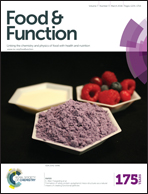Characterization of the antioxidant fraction of Trapa japonica pericarp and its hepatic protective effects in vitro and in vivo
Abstract
The ethanolic extract of Trapa japonica pericarp (TJP) and its various fractions were evaluated for their antioxidant potential. The ethyl acetate fraction (EF) from TJP exhibited significant antioxidant and protective effects against tert-butylhydroperoxide (t-BHP)-induced oxidative damage in vitro and in vivo. In vitro experimental results showed that the EF suppressed t-BHP-induced damage in Chang cells by inhibiting reactive oxygen species generation and regulating the mitochondrial membrane potential. Furthermore, western blot analysis showed that the EF effectively inhibited t-BHP-induced apoptosis by suppressing caspase-3, caspase-7, caspase-8, and caspase-9. In the in vivo study, the EF significantly prevented serum increases in glutamate oxaloacetate transaminase and glutamate pyruvate transaminase and hepatic malondialdehyde levels caused by t-BHP. Furthermore, the EF markedly increased hepatic superoxide dismutase, catalase, and glutathione levels. Histopathological examinations further confirmed that the EF could protect the liver from t-BHP-induced oxidative injury. These findings indicate that the EF could be developed as a therapy or to prevent hepatic injury.


 Please wait while we load your content...
Please wait while we load your content...